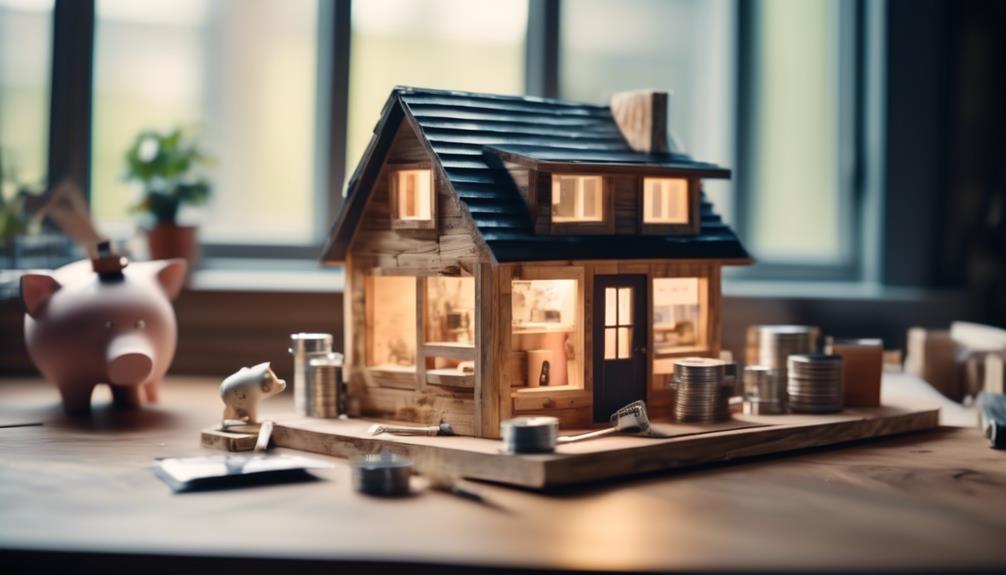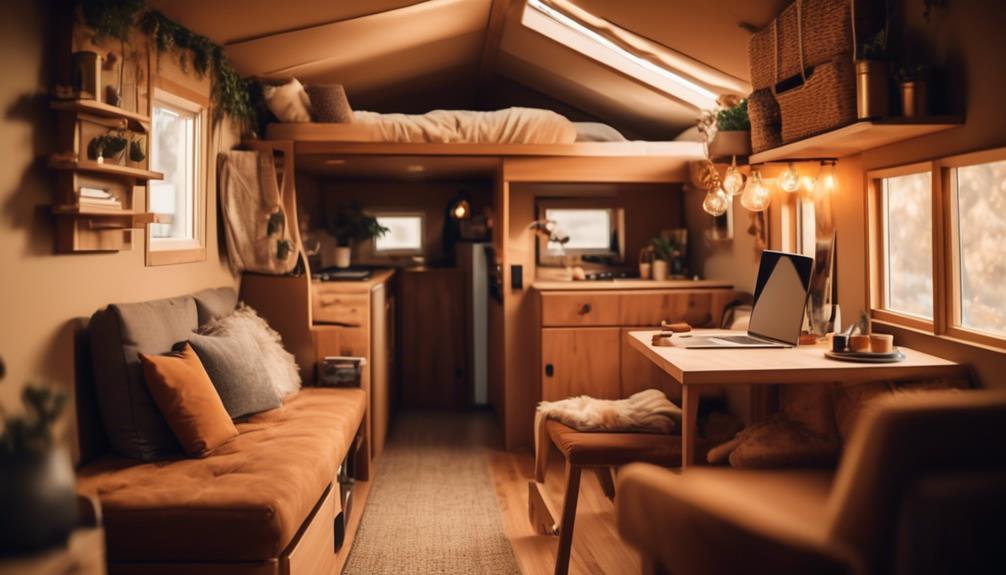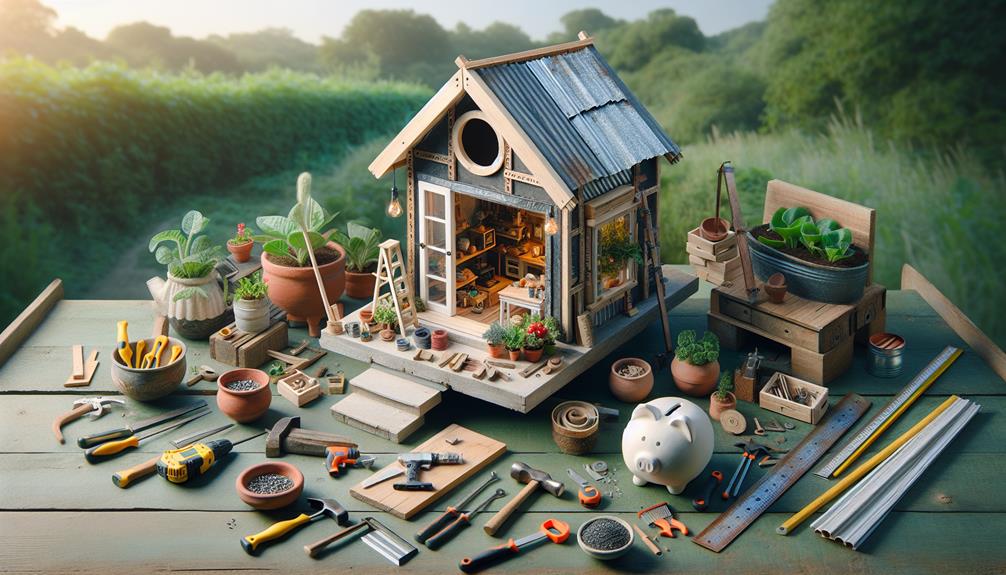Building your tiny home on a budget can be like threading a needle—requiring precision, patience, and a steady hand.
As you embark on this journey, you'll discover that prioritizing your features is key; deciding what you can't live without and what you can compromise on will shape your financial landscape.
You've likely heard of sourcing recycled materials, but the real trick is knowing where to look and how to assess their quality.
You're also considering the DIY route, aren't you? It's a path that can save you a significant amount, yet it's not without its challenges.
By the time you've laid the foundation—both literally and figuratively—you'll want to explore energy solutions that won't break the bank but will ensure you're not sacrificing comfort for cost.
So, where should you direct your efforts next to ensure your tiny home doesn't become a tiny money pit? Let's navigate the intricacies of building small without spending big.
Key Takeaways
- Researching and utilizing cost-saving features and materials such as insulation, roofing, and energy-efficient appliances is crucial for building a budget-friendly tiny home.
- Sourcing recycled materials from places like Habitat Restore, Craigslist, Facebook Marketplace, and local resources can significantly reduce construction costs.
- Adopting a DIY construction approach allows for cost savings by avoiding contractor fees, while also providing valuable hands-on experience and skill development.
- Exploring alternative energy solutions like solar panels, wind turbines, and generators can help reduce reliance on the power grid and lower long-term energy costs in a budget tiny home.
Prioritize Your Tiny Home Features
Assessing your tiny home's feature list critically will ensure you allocate your budget to the essentials that align with both your needs and lifestyle.
As you embark on your tiny house journey, remember that custom design can cost less than buying prefabricated models, granting you control to save money while building.
Tiny home builders often recommend prioritizing insulation, roofing, and energy-efficient appliances, as these are pivotal for comfort and sustainability.
Employ money-saving tips like opting for natural or reclaimed building materials to reduce the cost without compromising quality.
Dive into research to compare the cost-effectiveness of various materials for your tiny dwelling.
Engage with the community to refine your feature list, ensuring that every dollar spent advances your innovative, pragmatic home goals.
Source Recycled Building Materials
Having established your feature priorities, sourcing recycled building materials becomes a strategic step in stretching your budget further while contributing to sustainability. You'll not only save money but also reduce waste, making your building project more environmentally friendly.
Here's a pragmatic look at cost-effective sources:
| Source | Type of Materials | Benefit |
|---|---|---|
| Habitat Restore | Various recycled materials | Supports charity, reduces landfill |
| Craigslist | Inexpensive, diverse offerings | Local, often negotiable prices |
| Facebook Marketplace | Community-sourced repurposed items | Easy accessibility, community-driven |
| Onsite Resources | Natural materials, like local trees | Minimizes transport, ultra-sustainable |
| Tool-Sharing | Shared tools and spaces | Encourages collaboration, saves costs |
Consider these avenues for construction savings, fostering an innovative approach to your tiny home. Remember, repurposed items are not just cost-effective; they're keystones of a resourceful and environmentally conscious mindset.
Opt for a DIY Construction Approach

Embracing a DIY construction approach for your tiny home not only slashes labor costs but also empowers you with hands-on experience and skill development. When building a tiny house on your own, you strategically save money by sidestepping hefty contractor fees.
This self-reliant method enhances your skills for self-sufficiency and offers profound satisfaction. Moreover, a DIY construction approach enables you to make innovative choices that reflect your personal aesthetic, ensuring your tiny abode is tailored to your preferences.
Tips to save include repurposing materials, which also contributes to reduced costs. By managing the tiny house building process, you exert control over the timeline, potentially averting costly delays and ensuring saving money remains a central focus throughout the project.
Explore Alternative Energy Solutions
To maximize cost-efficiency and sustainability in your tiny home, consider exploring alternative energy solutions that lessen dependence on traditional power grids. Solar panels are a popular choice, reducing both ecological impact and the need for grid electricity, though initial costs can be high. Wind turbines offer green energy, but their reliability may vary based on location.
Pairing alternative energy solutions can save money in the long run and ensure a consistent power supply. Here's a pragmatic breakdown of options:
| Energy Solution | Initial Cost | Reliability |
|---|---|---|
| Solar Panels | High | High (Sun Dependent) |
| Wind Turbines | Medium | Variable |
| Generators | Low-Medium | High |
Incorporating these into the building process of your tiny home or tiny house on wheels can significantly cut costs and consumption.
Maximize Space With Multi-Functional Furniture

Maximize your tiny home's square footage by investing in multi-functional furniture that can transform and adapt to your living needs. When building your tiny house, design decisions are crucial, especially to save money and space.
Opt for a sofa bed or a murphy bed to make the most of your sleeping area. A fold-out desk can serve your work needs without occupying permanent room. Incorporate ottomans or benches with built-in compartments to couple storage with seating solutions.
To further maximize space, choose convertible dining tables that adjust in size according to necessity. Lastly, modular furniture systems offer dynamic reconfiguration, adapting seamlessly to various functions within your space.
These tips ensure every inch of your tiny home is efficiently utilized, merging style with multi-functional practicality.
Frequently Asked Questions
How Can I Save Money Building a Tiny House?
To save on your tiny house, tackle DIY projects, source upcycled components, and engage volunteer labor. Buy materials in bulk, choose simple designs, insulate efficiently, and opt for pre-owned appliances using local resources.
What Is the Cheapest Way to Power a Tiny House?
To power your tiny house cheaply, consider solar panels with battery storage or wind turbines, ensuring energy efficiency through LED lighting and insulation upgrades. Conduct an energy audit to tailor solutions for off-grid living.
How Much Money Do You Save With a Tiny House?
You'll embrace financial freedom, trimming your spending through space optimization, eco-friendly choices, and minimalist living. Tiny houses often sidestep hefty zoning levies, and DIY projects with alternative materials further shrink your expenses.
Is Building a Tiny House Cheaper Than Buying?
Building a tiny house can be cheaper than buying, especially if you choose simple designs, use secondhand materials, and take a DIY approach. However, land costs and zoning challenges could affect your savings.
Conclusion
In conclusion, by prioritizing essential features, using recycled materials, and embracing DIY, you'll craft a tiny home that's both budget-friendly and sustainable.
Imagine cozy evenings in a space lit by solar power, a testament to your resourcefulness and commitment to eco-friendly living.
Your hands-on approach isn't just economical; it's a tangible connection to your home, infusing every inch with personal value.
This pragmatic path ensures your tiny haven reflects both your financial savvy and environmental ethos.

